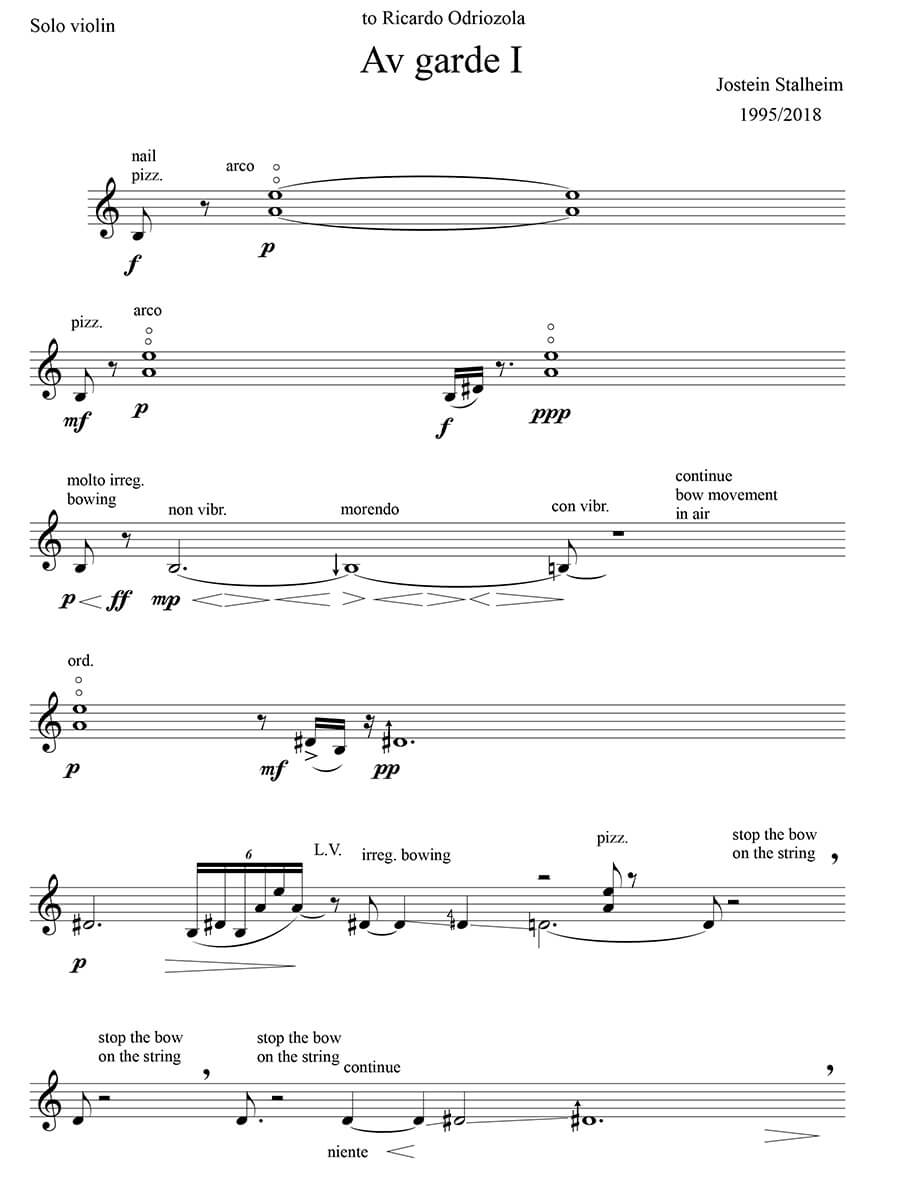Av Garde I for Solo violin (1995. Rev. 2018 / first print)
Stalheim, Jostein
14,00 €
Preface
Jostein Stalheim – Av Garde I (1995. Rev. 2018)
(b. Voss, 23. July 1960)
First performance: Gunnar Sævig Sal, Bergen
15. October 1995 Ricardo Odriozola
(German preface not available)
Jostein Stalheim was born in Voss, Norway in 1960 and started composing at an early age. When only 17 years old, his first works were broadcast on both radio and television. He studied composition and accordion at the Royal Conservatory of Music in Copenhagen, Sibelius Academy and at the Norwegian State Academy of Music. Stalheim appears regularly in European festivals as soundpainter, performer and composer.
Stalheim has written music for orchestra, chamber-ensembles, solo, multimedia and also site-specific productions. Stage music comprises a considerable part of his production; a.o. the opera “Pr.Warrants Progress” and the ballets; “Watch”, “Volatile”, “Alrekr” and “Kast”. He has worked in theatres both as composer and musician, among others The Royal Theatre in Copenhagen, Hordaland Teater, Den Nationale Scene, The Norwegian National Ballet and Danseteatret/Carte Blanche in Norway. He has received commissions from ensembles both in Norway and abroad.
Stalheim is internationally recognized as an accordion soloist and performs at festivals and with several international orchestras. He had his breakthrough in 1984 in Nordic Solistbiennale were he performed with Esa Pekka Salonen and Oslo Philharmonic Orchestra. He appears in numerous recordings, both as soloist, as chamber musician and with orchestra; for example Broderfolkonsert, the double concerto by Lasse Thoresen with Bergen Philharmonic Orchestra.
He received a Grant from Norwegian Art Council 2014-2015 to compose music for the opera La Peur et les Soins with libretto by Astrid Luisa Niebuhr. He has composed the music for Watch with premiere in Dansens Hus, Oslo.
Stalheim also contributed as a composer to the science opera Rosetta`s Stone; a cooperation between the two librettists Oded Ben-Horin, John F. McGrew and the co-composer John Bilotta with premiere August 12th 2016 in San Francisco. In the same year he had several large projects including Soundpainting with the contemporary ensemble BIT20 and Performance Artist Bergen.
Stalheim’s music has many endearing qualities. It often embraces the absurd and the illogical from an almost childlike perspective. There is never a hint of pretension in it and, with its deadpan delivery it often leaves the listener in doubt as to whether it is meant to be taken seriously or not seriously at all. In common with the music of Messiaen (a composer Stalheim deeply admires) Stalheim’s compositions tend, with their disarming honesty, to have a cleansing effect on the listener. His compositions often feel like suggestions rather than statements. They are never intrusive or imposing and are always entertaining, thought-provoking, surprising and permeated with a fundamental lightness.
Av garde I was written for Ricardo Odriozola, who premiered it at a concert given in Bergen with other works by Stalheim, Aagaard-Nilsen and Vaage.
The piece is part of a series of related works for different instrumental combinations, such as A La Larga, Corriendo and Avgardium Borealis. The common denominators of the series are time, distance and movement. Av garde I is the first work of the series.
The aspects of time and distance are best exemplified at the beginning and at the end of this brief work. The unexpected changes in dynamics, the subtle variations in pitch and the irregular modes of sound production all contribute to create a sense of openness and timelessness. Purposeful movement enters the music in the second system of page two, turning into a complex polyphonic dialogue that opens up a sense of vertical space, in page 3 and the first two systems of page 4. Thereafter the music reverts to the open, yet unsettled atmosphere of the beginning, ending with an elegant, unexpected upward flourish.
Stalheim specifies the following where it regards the use of microtones:
- Arrow (up or down) = 25-30 cents.
- Quartertone notation = ca. 50 cents
- Sharp with upward arrow = ca. 75 cents
- A difference of intonation between D sharp (just major third over B natural) and E flat is desirable. Applies particularly to page 2, systems 2-4.
Av garde I, with its characteristic Stalheim unassuming freshness, is an ideal work to “tune the air” and functions, therefore, really well as opening number for a concert. It was played in that position at the concert from which the available YouTube performance is taken. Please note that the original, unedited score was used in said performance. This explains the few discrepancies of pitch between that video recording and the present, definitive edition.
Ricardo Odriozola 21. February 2022
Score Data
| Sonderedition | Amethyst Edition |
|---|---|
| Genre | Solo Instrument |
| Format | 225 x 320 mm |
| Anmerkungen | Aufführungspartitur |
| Druck | Erstdruck |
| Seiten | 8 |
